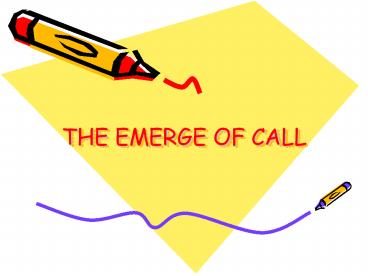THE EMERGE OF CALL - PowerPoint PPT Presentation
1 / 17
Title:
THE EMERGE OF CALL
Description:
THE EMERGE OF CALL CALL CALL stands for computer-assisted language learning CALL constantly change because of technological innovations CALL is a subject that tied ... – PowerPoint PPT presentation
Number of Views:71
Avg rating:3.0/5.0
Title: THE EMERGE OF CALL
1
THE EMERGE OF CALL
2
CALL
- CALL stands for computer-assisted language
learning - CALL constantly change because of technological
innovations - CALL is a subject that tied tightly to other
areas of study within applied linguistics such as
autonomy and other branches of knowledge such as
computer science - CALL is a young branch of applied linguistics and
still establishing its directions.
3
CALL
- Any process in which a learner uses a computer
and as a result, improve his or her language. - An awareness of this allows learners, teachers
and researches to recognize appropriate materials
and methodologies and adapt others to various
teaching and learning styles.
4
CALL
- Materials for CALL can include those which are
purpose-made for language learning, and those
which adapt existing computer-based materials,
video and other materials. - CALL can be used in the classroom as a reward for
a better learners or a remedial aid for weaker
ones.
5
CALL
- Terms in CALL (page 9 to 10)
- CAI
- CAL
- CALI
- CALT
- CAT
- CBT
- CMC
- CMI
- ICALL
- TELL
- WELL
6
M.M Kenning and MJ Kenning
- Talks about the early benefit of providing
autonomous learning style materials - Benefits of privacy and individualization
- Each students can use the computer to review the
grammar at his own speed with special emphasis on
areas where he is weak - And a few later, the computer can correct mistake
privately and repeatedly without the aggravation
that sometimes accompanies such public correction.
7
CALL
- Autonomy is fostered by CALL in different ways.
Call can present opportunities for learners to
study on their own, independent of a teacher - CALL offers opportunities for learners to direct
their own learning. - CALL materials, regardless of their design, allow
for endless revisiting that can help learners
review those parts for which they need more
practice
8
Technology driving CALL
- In the last four decades, Call materials have
gone from an emphasis on basic textual
gap-filling tasks and simple programming exercise
to interactive multimedia presentations with
sound, animation and full-motion video.
9
Technology driving CALL
- Barrier in CALL
- Materials designers are often either teachers
with limited technical skills or competent
technicians with no experience in teaching - Software authoring programs often include simple
ways to create gap-filling exercises that are
seductively easy to use
10
CALL barries
- CALL materials is the lack of ways to monitor and
correct unpredictable student answers. - Example in a sentence in which the keyword
answers were designed as talking and phone, the
computer would - Overlook incorrect syntax (Talking he telephone
on) - Be confused by variations in grammar (He talks on
the telephone) - Fail to accept synonyms ( The man is speaking on
the phone) - Fail to notice erroneous and extraneous words
(She is be talking and waiting on the telephone
thing). - THE SOLUTION to have learners emails or
otherwise save answers for teachers who then mark
them by hand
11
Technology driving CALL
- Many brave attempts have been made to have the
computer teach writing, but the failure of such
system is always rooted in the computer inability
to accommodate unpredictable learner output.
12
J. Murray on the limitations of natural-language
processing
- Such pattern-matching programs have severe
limitations. For machines to understand and
produce language, they must be able to process
natural language at the morpho-syntactic,
semantic and discourse levels. For spoken
language, the system also needs to process
language at the phonetic and phonological level.
13
The Changing Focus of Research in CALL
- C.M. Neuwirth and D.S. Kaufer on the dominant
pattern of research in CALL - Thus far, the dominant pattern of (research) in
computers and compositions studies has involved
empirical questions about existing software
asking for example, Do word processors improve
writing quality or revision performance?
usually by experimental comparison to some
traditional technology for writing such as pen
and paper
14
The Changing Focus of Research in CALL
- Research in early years focus on whether or not
computers should be used in the classroom for the
learning of languages is no longer pertinent.
Computer appears to stay. - The presence of computers in educational contexts
has grown from a single unit in one or more
classroom to computer labs and even to widespread
individual ownership by students in some
countries.
15
The Changing Focus of Research in CALL
- Research is now directed into how computers
should be used and what purposes but a major
challenge to many studies in CALL remains a lack
of empirical research. - Meich, Nave and Mosteller (1996) in an
examination of 22 empirical CALL studies
conducted between 1989 and 1994 concluded that
CALL can substantially improve achievements as
compared with traditional instruction
16
The Changing Focus of Research in CALL
- Longan (1995) explores the importance of computer
literacy. - He suggests that computers represent the fifth in
a series of languages which humans have mastered,
the previous four being speech, writing,
mathematics and science. - He also suggests that a failure to recognize
computers as a new language has led to the
inappropriate teaching and uses of computers.
17
The Changing Focus of Research in CALL
- Such studies inevitably ignore the special
features of computers organization and
presentation of information, particularly learner
centered opportunities to explore different links
( or paths of inquiry) and the appropriateness of
multimedia models for accommodating different
learners learning styles and even gender.































